Sea
Life
Seahorse
Definition:
About 35
species of seahorses occur worldwide. The seahorse's scientific genus
name Hippocampus is a Greek word meaning "bent horse."
Depending on the species, seahorses reach lengths of about 2-14 in. 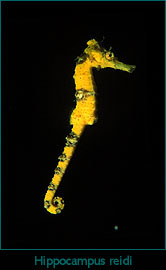 The
name is derived from the resemblance of the head to that of a horse.
It has long, tubular jaws much like a snout. The body is compressed,
with an elongated tail, and the external covering is a series of
large, rectangular bony plates, with spines and projections along the
lines of juncture. These spines, together with the divided, streamer
like fins of some species, give them a strong resemblance to the
seaweeds among which they live. About 30 species are found in various
warm and temperate seas. All keep near the shore, often developing in
brackish water. The common sea horse of the Atlantic coast of North
America is one of the largest species, reaching a length of more than
5 in. The Pacific seahorse is the only seahorse on the eastern
Pacific coast (found from California to Peru).
The
name is derived from the resemblance of the head to that of a horse.
It has long, tubular jaws much like a snout. The body is compressed,
with an elongated tail, and the external covering is a series of
large, rectangular bony plates, with spines and projections along the
lines of juncture. These spines, together with the divided, streamer
like fins of some species, give them a strong resemblance to the
seaweeds among which they live. About 30 species are found in various
warm and temperate seas. All keep near the shore, often developing in
brackish water. The common sea horse of the Atlantic coast of North
America is one of the largest species, reaching a length of more than
5 in. The Pacific seahorse is the only seahorse on the eastern
Pacific coast (found from California to Peru).
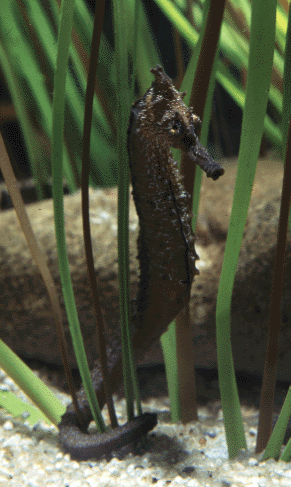 Camouflage:
Camouflage:
Seahorses
can change color to match their background. They grow long skin
appendages so that they blend in better with the algae. They let
encrusting organisms settle on them. There are approximately four
species around North America down to South America. They range in
size from a very small species, sometimes known as the dwarf
seahorse, which is only about an inch long, up to a species off the
Pacific Coast of Central America that gets to be about a foot long
called Hippocampus ingens. And then there's Hippocampus reidi, which
is found in the Caribbean in coral reefs. It's quite a slender, but
quite large seahorse, when they dance they turn fluorescent neon
colors. And then Hippocampus erectus is quite a big chunky seahorse
and it's found from Nova Scotia all the way down to perhaps Uruguay.
Love
Life:
Very few
animals stick with one partner for life. Humans are unusual in that
respect. In fishes, 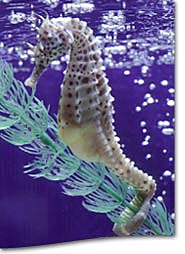 monogamy
is particularly rare. So it was a bit surprising to find that
seahorses were monogamous. We have evidence suggesting that when
seahorses stick with a partner for a while they get better at
producing babies as a team.
monogamy
is particularly rare. So it was a bit surprising to find that
seahorses were monogamous. We have evidence suggesting that when
seahorses stick with a partner for a while they get better at
producing babies as a team.
Super
Dads:
Like the
pipefishes, the males take charge of the eggs, which are placed in an
abdominal pouch and remain there until they hatch. We tend to think
of parental care as being the responsibility of the female, but
that's because we're mammals. In birds, if you think about it, both
parents usually care for the young. And in fishes, people are often
surprised to learn that usually the parental care is given only by
the male. Parental care in fishes usually involves just guarding the
eggs, fanning the eggs, making sure they get enough oxygen and
they're clean. The seahorses are the most extreme example of fathers
providing the care that we know in the animal world. Because they
guard the eggs all right, but they guard them on their body. They
also provide oxygen through a capillary network in the pouch, and
they also transfer nutrients, and they control the pouch environment
so that it changes during the pregnancy to become more like salt
water. This is an extreme example, but instead of producing many
small young, the seahorses produce fewer, but better developed and
larger young. A female seahorse deposits 100 or more eggs into the
pouch on the male's abdomen. The male releases sperm into the pouch,
fertilizing the eggs. The embryos develop within the male's pouch,
nourished by their individual yolk sacs. Incubation may last two to
six weeks, depending on the seahorse species. After the embryos have
developed, the male gives birth to tiny seahorses, some as small as
0.4 in. long.
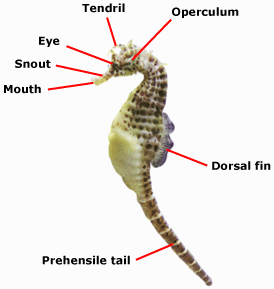 Endangered:
Endangered:
Virtually
all seahorses are listed on the 1996 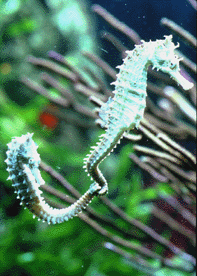 International
Union for the Conservation of Nature "red list." And the
"red list" acts like a flag. It warns you that species are
considered to be at risk, without enforcing any regulations. We know
that the seahorse populations we've been able to examine are
declining quite dramatically -- on the order of 25 to 50 percent over
five years. There's tremendous difficulty with consumption of
seahorses for traditional Chinese medicines, for the aquarium trade
and also for curiosities and souvenirs. Traditional Chinese medicine
is the biggest user of seahorses, and the numbers involved in that
trade may amount to more than 20 million a year. And it's not just
ethnic Chinese communities; the Indonesians, the Central Filipinos,
and a whole host of other racial and ethnic groups around the world
also use seahorses as medicines. Hundreds of thousands of seahorses
are used each year, as well, for the aquarium trade. And the aquarium
trade is primarily driven by North American consumption. Most of
these seahorses are juveniles, they haven't even bred, they haven't
even reproduced when we buy them and put them in our home aquariums,
where they usually die. And then the curiosity trade is, again,
hundreds of thousands of animals each year. It's pretty hard to
justify having a seahorse on a key chain or on your mantelpiece when
you know that's depleting wild populations. And seahorses live in
some of the world's most threatened habitats: sea grasses, mangroves,
coral reefs and estuaries. We're working very hard to draw attention
to the habitat loss.
International
Union for the Conservation of Nature "red list." And the
"red list" acts like a flag. It warns you that species are
considered to be at risk, without enforcing any regulations. We know
that the seahorse populations we've been able to examine are
declining quite dramatically -- on the order of 25 to 50 percent over
five years. There's tremendous difficulty with consumption of
seahorses for traditional Chinese medicines, for the aquarium trade
and also for curiosities and souvenirs. Traditional Chinese medicine
is the biggest user of seahorses, and the numbers involved in that
trade may amount to more than 20 million a year. And it's not just
ethnic Chinese communities; the Indonesians, the Central Filipinos,
and a whole host of other racial and ethnic groups around the world
also use seahorses as medicines. Hundreds of thousands of seahorses
are used each year, as well, for the aquarium trade. And the aquarium
trade is primarily driven by North American consumption. Most of
these seahorses are juveniles, they haven't even bred, they haven't
even reproduced when we buy them and put them in our home aquariums,
where they usually die. And then the curiosity trade is, again,
hundreds of thousands of animals each year. It's pretty hard to
justify having a seahorse on a key chain or on your mantelpiece when
you know that's depleting wild populations. And seahorses live in
some of the world's most threatened habitats: sea grasses, mangroves,
coral reefs and estuaries. We're working very hard to draw attention
to the habitat loss.
Behavior:
Seahorses
are well camouflaged among the eelgrasses and seaweeds in which they
make  their
homes. A seahorse often moors itself in the water by curling its
prehensile tail around sea grasses and coral branches. The seahorse's
small mouth, located at the end of its narrow tube like snout, sucks
up tiny plankton and fish larvae.
their
homes. A seahorse often moors itself in the water by curling its
prehensile tail around sea grasses and coral branches. The seahorse's
small mouth, located at the end of its narrow tube like snout, sucks
up tiny plankton and fish larvae.
Seahorses swim
upright. Pectoral fins on the sides and a small dorsal fin on the
back of a seahorse's body wave rapidly to move the seahorse through
the water.
Check these
links for more information on Seahorses.
http://www.seahorses.de/seahorses.htm
http://www.seahorseaquaculture.com.au/frame.html
 The
name is derived from the resemblance of the head to that of a horse.
It has long, tubular jaws much like a snout. The body is compressed,
with an elongated tail, and the external covering is a series of
large, rectangular bony plates, with spines and projections along the
lines of juncture. These spines, together with the divided, streamer
like fins of some species, give them a strong resemblance to the
seaweeds among which they live. About 30 species are found in various
warm and temperate seas. All keep near the shore, often developing in
brackish water. The common sea horse of the Atlantic coast of North
America is one of the largest species, reaching a length of more than
5 in. The Pacific seahorse is the only seahorse on the eastern
Pacific coast (found from California to Peru).
The
name is derived from the resemblance of the head to that of a horse.
It has long, tubular jaws much like a snout. The body is compressed,
with an elongated tail, and the external covering is a series of
large, rectangular bony plates, with spines and projections along the
lines of juncture. These spines, together with the divided, streamer
like fins of some species, give them a strong resemblance to the
seaweeds among which they live. About 30 species are found in various
warm and temperate seas. All keep near the shore, often developing in
brackish water. The common sea horse of the Atlantic coast of North
America is one of the largest species, reaching a length of more than
5 in. The Pacific seahorse is the only seahorse on the eastern
Pacific coast (found from California to Peru). Camouflage:
Camouflage: monogamy
is particularly rare. So it was a bit surprising to find that
seahorses were monogamous. We have evidence suggesting that when
seahorses stick with a partner for a while they get better at
producing babies as a team.
monogamy
is particularly rare. So it was a bit surprising to find that
seahorses were monogamous. We have evidence suggesting that when
seahorses stick with a partner for a while they get better at
producing babies as a team. Endangered:
Endangered: International
Union for the Conservation of Nature "red list." And the
"red list" acts like a flag. It warns you that species are
considered to be at risk, without enforcing any regulations. We know
that the seahorse populations we've been able to examine are
declining quite dramatically -- on the order of 25 to 50 percent over
five years. There's tremendous difficulty with consumption of
seahorses for traditional Chinese medicines, for the aquarium trade
and also for curiosities and souvenirs. Traditional Chinese medicine
is the biggest user of seahorses, and the numbers involved in that
trade may amount to more than 20 million a year. And it's not just
ethnic Chinese communities; the Indonesians, the Central Filipinos,
and a whole host of other racial and ethnic groups around the world
also use seahorses as medicines. Hundreds of thousands of seahorses
are used each year, as well, for the aquarium trade. And the aquarium
trade is primarily driven by North American consumption. Most of
these seahorses are juveniles, they haven't even bred, they haven't
even reproduced when we buy them and put them in our home aquariums,
where they usually die. And then the curiosity trade is, again,
hundreds of thousands of animals each year. It's pretty hard to
justify having a seahorse on a key chain or on your mantelpiece when
you know that's depleting wild populations. And seahorses live in
some of the world's most threatened habitats: sea grasses, mangroves,
coral reefs and estuaries. We're working very hard to draw attention
to the habitat loss.
International
Union for the Conservation of Nature "red list." And the
"red list" acts like a flag. It warns you that species are
considered to be at risk, without enforcing any regulations. We know
that the seahorse populations we've been able to examine are
declining quite dramatically -- on the order of 25 to 50 percent over
five years. There's tremendous difficulty with consumption of
seahorses for traditional Chinese medicines, for the aquarium trade
and also for curiosities and souvenirs. Traditional Chinese medicine
is the biggest user of seahorses, and the numbers involved in that
trade may amount to more than 20 million a year. And it's not just
ethnic Chinese communities; the Indonesians, the Central Filipinos,
and a whole host of other racial and ethnic groups around the world
also use seahorses as medicines. Hundreds of thousands of seahorses
are used each year, as well, for the aquarium trade. And the aquarium
trade is primarily driven by North American consumption. Most of
these seahorses are juveniles, they haven't even bred, they haven't
even reproduced when we buy them and put them in our home aquariums,
where they usually die. And then the curiosity trade is, again,
hundreds of thousands of animals each year. It's pretty hard to
justify having a seahorse on a key chain or on your mantelpiece when
you know that's depleting wild populations. And seahorses live in
some of the world's most threatened habitats: sea grasses, mangroves,
coral reefs and estuaries. We're working very hard to draw attention
to the habitat loss. their
homes. A seahorse often moors itself in the water by curling its
prehensile tail around sea grasses and coral branches. The seahorse's
small mouth, located at the end of its narrow tube like snout, sucks
up tiny plankton and fish larvae.
their
homes. A seahorse often moors itself in the water by curling its
prehensile tail around sea grasses and coral branches. The seahorse's
small mouth, located at the end of its narrow tube like snout, sucks
up tiny plankton and fish larvae.